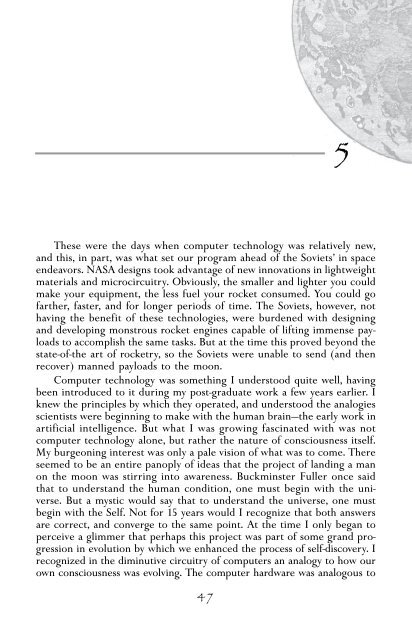edgar-mitchell
edgar-mitchell
edgar-mitchell
You also want an ePaper? Increase the reach of your titles
YUMPU automatically turns print PDFs into web optimized ePapers that Google loves.
24<br />
The Way of the Explorer<br />
From the center of town the echo of hymns could be heard on Sunday<br />
morning as they issued out from under a white steeple. Perhaps I was taught<br />
the fear of God in this setting because it seemed obvious that there was so<br />
much to fear. But I grew out of a tradition of self-reliance and trust in<br />
one’s instincts, those mythic values of the Old West, and as I came into<br />
adolescence I suppose it was natural to question precisely why we should<br />
live so fearfully. My grandfather certainly did not. He was known around<br />
these parts as Bull Mitchell because of his livestock-trading acumen. Some<br />
of the ranchers who would later grow wealthy (though you wouldn’t know<br />
it by their bent and sweat-stained Stetsons) often went down to Argentina<br />
or Brazil on business and sent back postcards with no address other than<br />
“Bull Mitchell, New Mexico.” And he would generally get his mail. That is<br />
to say, he was widely known, but to a child he was immortal, bullet-proof.<br />
Above all else, he was fearless.<br />
From the very beginning I naturally gravitated toward the male side of<br />
the family. I have memories from when I was a young boy of a trail of red<br />
cedar shavings strewn along the concrete sidewalks of Roswell that I would<br />
follow this way and that, drawn along by the magnetic pull of my grandfather<br />
as he whittled through a lazy afternoon. He would casually move<br />
here and there, whittling, wherever conversation with friends or a cattle<br />
deal led him. He was the center, and seemingly the originator, of his own<br />
universe.<br />
I recall the wide-bodied car he owned in later years, a 1946 Ford, and<br />
how he drove it between stationary objects. The once-proud, bulbous fenders<br />
were wrinkled, crimped from my grandfather’s habit of driving through<br />
narrow spaces where only a horse could pass. But he felt entitled to go<br />
wherever he chose, and that the car was obligated to take him. The condition<br />
of its body spoke volumes of his nature: a 19th-century man set in the<br />
vertiginous 20th century; a man born out of time.<br />
Just a mile or so down the road from where I was raised lived a man I<br />
imagine was not unlike my grandfather—a man who is now considered the<br />
father of rocketry. This was deep in the bleakness of World War II. Across<br />
an ocean, his German successor, Werhner von Braun, was busy designing<br />
the rockets known as the V-I and V-2, which were arcing across the<br />
English Channel and detonating when they collided with downtown<br />
London. Each day as I walked to school along the white gravel road I<br />
would pass the quiet country home where a mad scientist was said to live.<br />
He was, quite literally, a rocket scientist. He was also America’s first, and<br />
his name was Robert Goddard.<br />
The house was generally quiet. He had recently moved from Massachusetts<br />
(some say he was invited to leave), and now worked and studied in austere<br />
isolation—far from sensitive populations and their demands for quiet and


